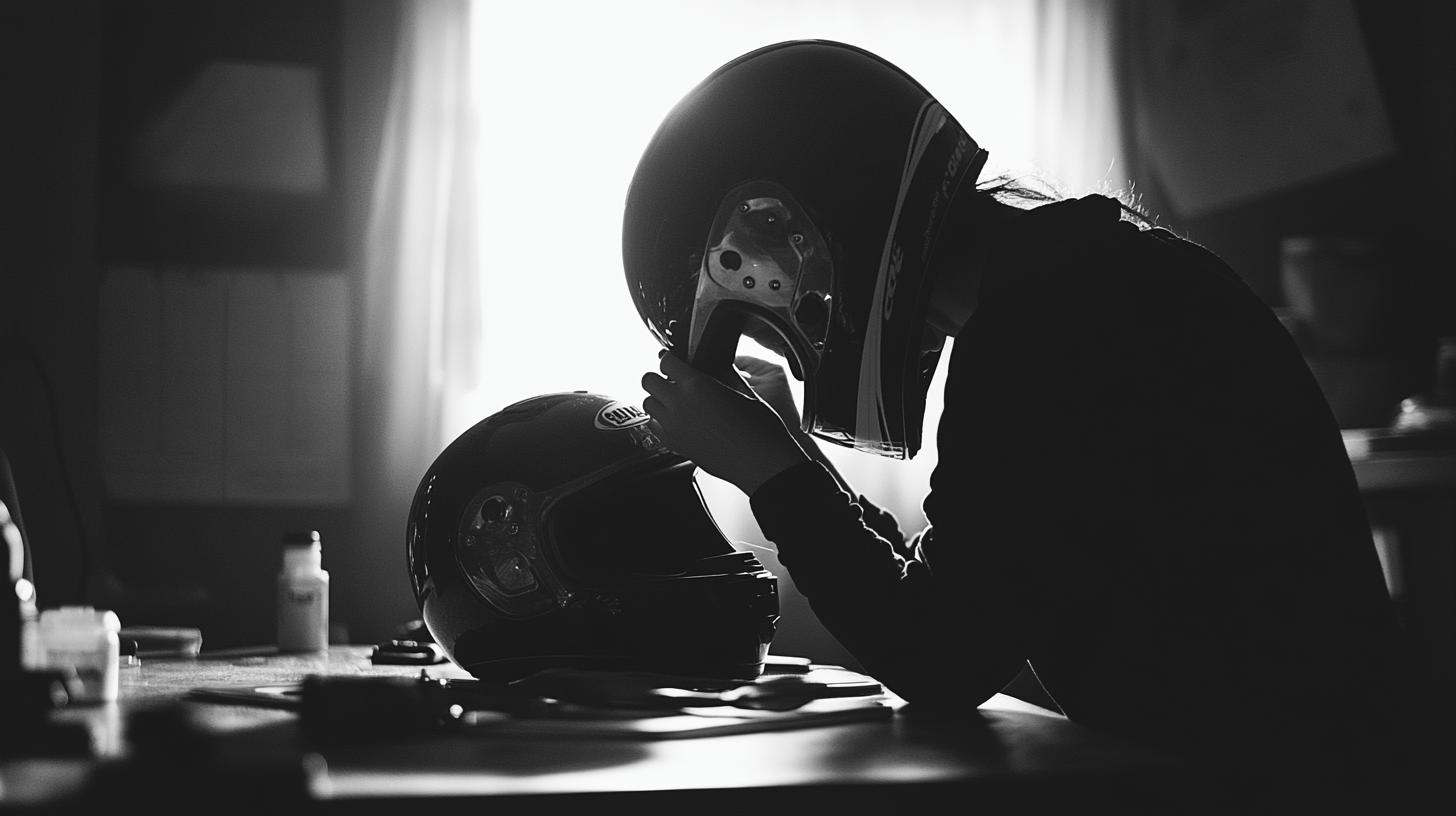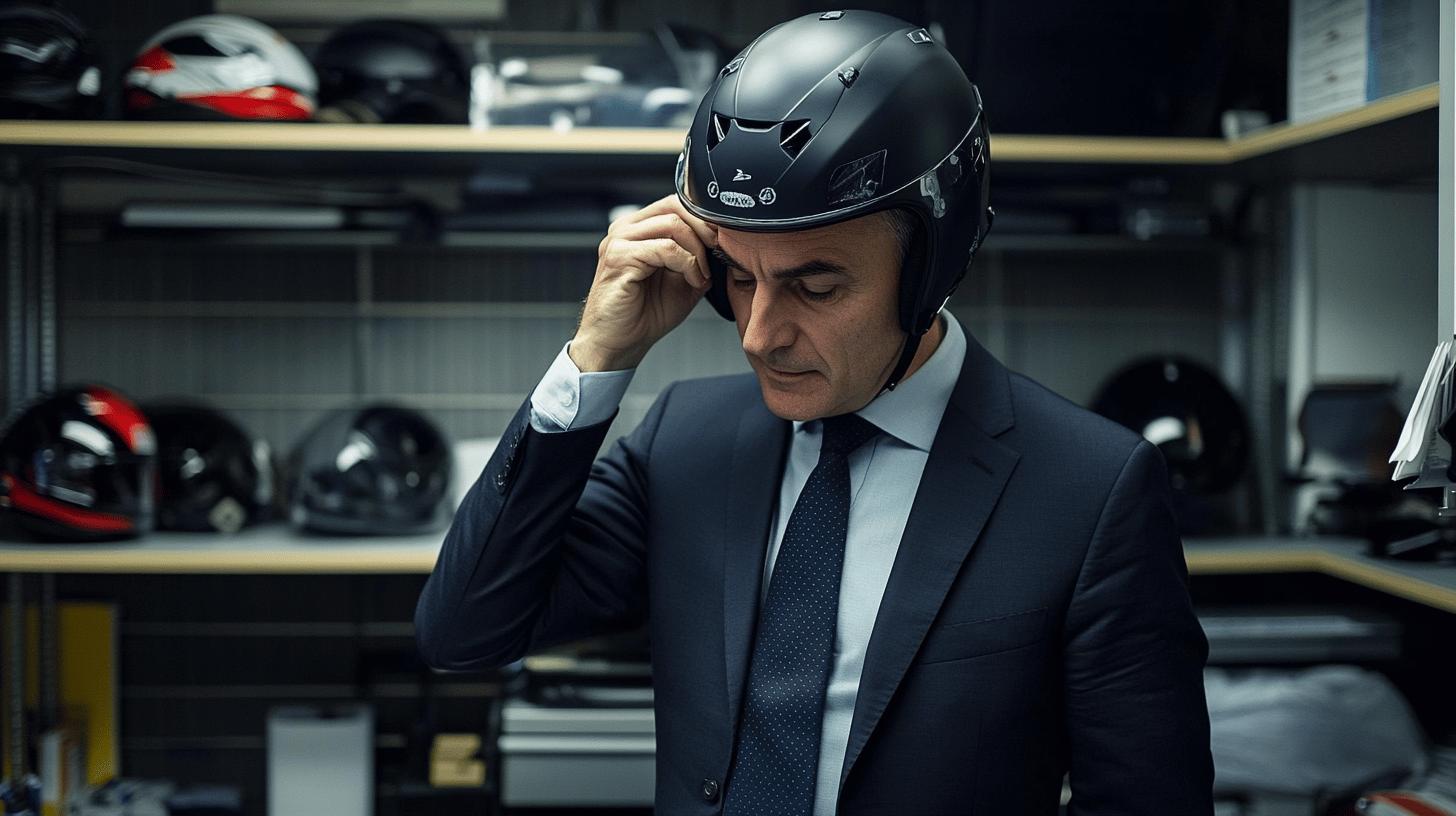Is your motorcycle helmet feeling more like a crown that's just a bit too high up? You're not alone in seeking that elusive, snug fit that keeps comfort and safety riding side by side.
Understanding how to make a helmet sit lower can transform your riding experience, giving you the confidence and protection every rider craves. It's not just about tinkering with padding—it's about knowing your helmet inside and out.
In this guide, we delve into practical techniques and safety-conscious strategies to make sure your helmet fits just right.
Understanding How to Make Your Motorcycle Helmet Sit Lower

A well-fitting motorcycle helmet is paramount for ensuring both safety and comfort while riding. The integrity of the helmet fit directly impacts its effectiveness in protecting the head during an accident.
A helmet that sits too high can compromise protection, reduce visibility, and cause discomfort over time. Achieving a lower fit can enhance stability and comfort, minimizing distractions while riding. A snug fit also prevents the helmet from tilting forward or backward, which can obstruct vision and cause strain on the neck.
To properly adjust a helmet's fit and make it sit lower, begin by accurately measuring your head size and shape:
-
Use a flexible tape measure to measure around the largest part of your head, usually above the eyebrows and ears.
-
Wrap the tape measure snugly but not too tight, ensuring it is level all around.
-
Record the circumference in centimeters or inches, depending on the helmet sizing chart you will be using.
-
Take a photo of the top of your head to identify your head shape as either round oval or long oval, which affects helmet fit.
-
Consult the helmet manufacturer's sizing chart to select the appropriate size based on your measurements and head shape.
The shape of your head plays a critical role in how a helmet fits and sits. Round oval, intermediate oval, and long oval are common head shapes that influence helmet design.
A mismatch between the helmet shape and your head shape can lead to pressure points and discomfort, prompting the need for adjustments to achieve a lower and more secure fit. Adjusting the helmet to match your head's contour ensures even weight distribution, reducing fatigue during long rides.
Adjusting Helmet Fit and Modifying Padding for a Lower Position

Adjusting the interior padding of a motorcycle helmet is a practical approach to enhancing its fit, ensuring it sits lower on the head for improved comfort and safety. Proper padding adjustment can alleviate issues such as excessive movement and pressure points that arise from a poor fit.
By customizing the thickness and placement of cheek pads, riders can achieve a snugger fit that not only secures the helmet in place but also optimizes its protective capacity. Cheek pads are available in various thicknesses, allowing for a tailored adjustment to accommodate different head shapes and sizes. It's essential to modify padding carefully to avoid compromising the helmet's structural integrity or safety features.
Here are steps to safely remove or replace helmet padding:
-
Consult the helmet manual for specific instructions on padding removal.
-
Identify the padding sections that need adjustment, such as cheek pads or crown liners.
-
Gently detach the padding by unfastening any snaps or Velcro attachments.
-
Select replacement padding with the desired thickness for a better fit.
-
Position the new padding securely, ensuring it aligns with the helmet's interior contours.
-
Reattach the padding using the original fastening mechanisms, checking for secure placement.
- Test the helmet fit by wearing it to confirm improved comfort and stability.
Following safety guidelines is crucial when adjusting helmet fit. Any modifications should not interfere with the helmet's ability to absorb impact or maintain its position during a collision. It's advisable to make incremental changes and test the fit regularly, ensuring that the helmet remains both comfortable and secure.
| Cheek Pad Thickness (mm) | Impact on Fit |
|---|---|
| 20 mm | Snug fit for narrow faces |
| 25 mm | Standard fit, balances comfort and security |
| 30 mm | Looser fit for wider faces |
Helmet Customization Techniques for Improved Comfort

Customizing a motorcycle helmet can significantly enhance comfort and ensure a snug fit, which is crucial for both safety and enjoyment during rides. A helmet that fits well can prevent movement, reduce pressure points, and decrease noise, contributing to a more comfortable experience.
Customization techniques such as swapping cheek pads or using custom inserts allow riders to tailor the helmet to their specific head shape and size, ensuring optimal fit and comfort. Premium helmets often come with features like multi-piece removable liners, which provide the flexibility needed for these adjustments.
Here are methods to customize your helmet for improved comfort:
-
Swap cheek pads to adjust the fit around the jawline and cheeks.
-
Use custom inserts to fill gaps and ensure even weight distribution.
-
Adjust the crown liner for better fit on top of the head.
-
Select a helmet with multi-piece liners for easy customization.
-
Utilize adjustable straps to secure the helmet without feeling tight.
-
Consider helmets with ergonomic designs for specific head shapes.
Ventilation is another crucial aspect of helmet comfort, as it can influence the temperature and airflow inside the helmet. Helmets with adjustable ventilation features allow riders to control the amount of air entering and exiting, which can help reduce heat buildup and moisture.
This is particularly beneficial during long rides or in warm weather, as maintaining a comfortable internal environment can prevent fatigue and enhance focus. Ensuring that the helmet's ventilation system is functioning properly and is easy to adjust can provide a significant boost to overall comfort.
Exploring Professional Helmet Fit Solutions

Why should one consider professional helmet fitting services? Precision: Professional services offer expert advice on achieving the perfect helmet fit, ensuring both comfort and safety. These experts possess a deep understanding of various helmet brands, models, and the intricacies of head shapes.
With their guidance, riders can achieve a personalized fit that minimizes pressure points and enhances stability. Professional fitters can suggest adjustments and modifications that an individual might overlook, offering a tailored approach to helmet fitting that can prevent discomfort during long rides.
Can helmet safety be compromised by improper modifications? Yes: Consulting a professional is crucial to ensure that any modifications do not compromise helmet safety. Professionals are trained to maintain the structural integrity of the helmet while making necessary adjustments.
They can identify potential issues, such as incorrect padding alterations or improper strap adjustments, that might affect the helmet's ability to protect during an impact. By relying on their expertise, riders can confidently make changes that will not detract from the helmet's protective capabilities, thus maintaining its full safety potential.
Troubleshooting Common Helmet Fit Issues

Common helmet fit issues can significantly impact both safety and comfort during motorcycle rides. Poor fit often manifests as forehead pressure, ear tightness, or jaw discomfort, which can lead to headaches and restricted vision. These symptoms indicate a helmet that may be too small or improperly adjusted.
A helmet that sits too high can also cause neck strain as it shifts position during movement. Ensuring the helmet fits snugly without causing pressure points is crucial for maintaining focus and reducing fatigue on the road. Achieving a comfortable fit requires attention to the helmet's interior padding and straps, which should contour to the rider's head shape without compressing critical areas.
Here are solutions to resolve common helmet discomfort issues:
-
Forehead pressure: Adjust the crown padding or try a helmet with a different shell shape to alleviate tightness.
-
Ear tightness: Replace cheek pads with thinner ones to reduce pressure around the ears.
-
Jaw discomfort: Ensure chin straps are correctly adjusted and look for helmets with adjustable chin bar positions.
-
Headaches: Consider a larger helmet size or a model designed for your specific head shape.
-
Restricted vision: Reposition the helmet to sit lower or choose a model with a wider eye port for improved visibility.
Addressing helmet fit issues is vital for both safety and rider comfort. A well-fitted helmet enhances protective capabilities by remaining securely in place during an accident. Proper fit also prevents distractions caused by discomfort, enabling riders to maintain concentration. Regularly assessing helmet fit and making necessary adjustments ensures that the helmet remains an effective safety tool throughout its lifespan.
Final Words
Mastering the art of fitting a helmet properly begins with understanding head shape and measurements. Techniques like adjusting padding and exploring customization can make helmets sit lower, enhancing comfort.
Professional fitting services ensure these modifications do not compromise safety. Recognizing and addressing fit issues, such as pressure points, is crucial. Enhancing helmet fit not only boosts the riding experience but also promotes confidence and security.
FAQ
How can I make my motorcycle helmet fit better?
To make a motorcycle helmet fit better, adjust the interior padding or replace cheek pads with different thicknesses. Ensure the helmet fits snugly without causing discomfort, especially around the cheeks and forehead.
How to make a motorcycle helmet sit lower?
Modify the interior padding by adding thinner liners or padding in the crown area. This helps lower the helmet's position on your head without compromising safety.
What if my motorcycle helmet is slightly too big?
If your motorcycle helmet is slightly too big, consider using thicker cheek pads or additional padding to achieve a more secure fit. Ensure it provides stability during movement without excessive shifting.
How much should a motorcycle helmet squeeze your cheeks?
A motorcycle helmet should gently squeeze your cheeks without causing pain or excessive pressure. The fit should be secure but comfortable, ensuring good stability without restricting jaw movement.
What happens if your helmet is too big?
A helmet that is too big may shift during riding, reducing protection and potentially causing neck strain. It can also increase wind noise and reduce visibility due to improper alignment.
Can motorcycle helmets be dropped?
Dropping a motorcycle helmet can compromise its structural integrity, even if no visible damage is apparent. It's recommended to have it inspected for safety if dropped.
Should a motorcycle helmet be hard to take off?
A motorcycle helmet should fit securely yet allow reasonable ease of removal. It shouldn’t come off too easily during riding but also shouldn’t require significant force to remove.
Why might my motorcycle helmet feel tight on my forehead?
A tight helmet on the forehead could indicate incorrect sizing or improper head shape alignment. Consider trying different helmet sizes or shapes, like round or long oval, for a better fit.

Brad Mitchell is a seasoned motorcycle enthusiast with over 16 years of riding experience. He’s spent countless hours on the open road, particularly favoring scenic routes aboard his trusted Harley-Davidson. Brad’s laid-back approach to life and riding gives him a unique perspective on motorcycle gear and safety, which he shares through his in-depth reviews and expert advice on ProtectiveGearz.



